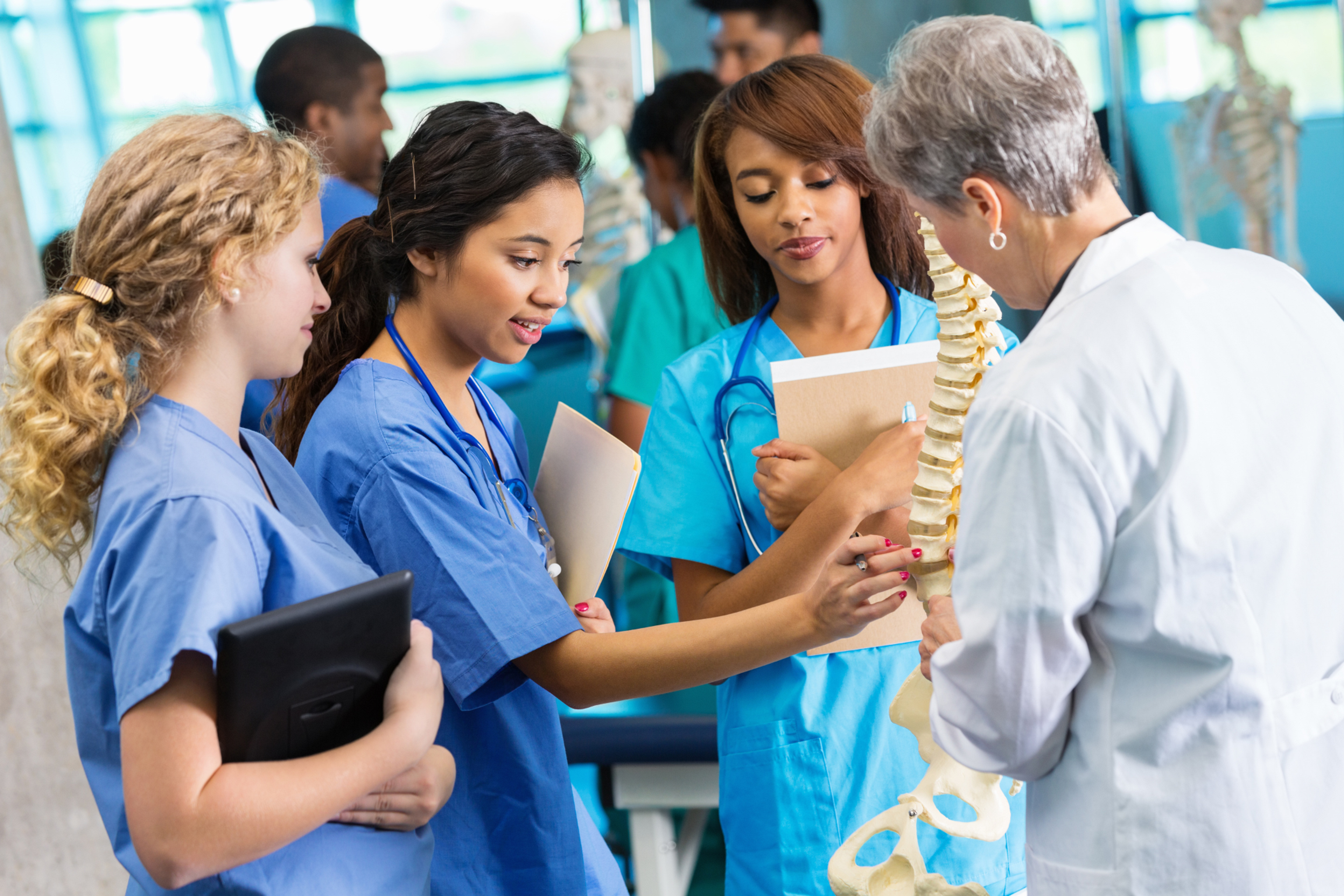How to Become a Radiologist: Schooling, Career Path, & Salary
Are you interested in becoming a radiologist? This comprehensive guide covers everything you need to know about the education, licensing, and career options available in this exciting field.
Posted April 1, 2025

Table of Contents
A radiologist is a medical doctor who specializes in interpreting medical images to diagnose and treat diseases. This field is critical in modern healthcare, as radiologists use medical imaging techniques such as CT scans, MRIs, ultrasounds, and X-rays to provide accurate diagnoses. Some radiologists also perform minimally invasive procedures using imaging guidance, known as interventional radiology. The process of becoming a radiologist requires extensive education and training. It typically takes 13-15 years, including a bachelor's degree, medical school, a radiology residency, and sometimes a fellowship program for additional specialization.
This guide explains the entire path to becoming a radiologist, the different specialties available, and salary expectations.

What is a Radiologist?
A radiologist is a medical doctor trained in medical imaging technology who plays a key role in diagnosing and treating diseases. These physicians specialize in interpreting medical images from CT scans, MRIs, ultrasounds, X-rays, and nuclear medicine studies to help guide patient care. Some radiologists, particularly interventional radiologists, go beyond image interpretation and perform minimally invasive procedures using imaging guidance to treat conditions such as tumors, blood clots, and spinal fractures. Others focus on radiation therapy to treat cancer as radiation oncologists. Radiologists work closely with other healthcare professionals, including primary care doctors, surgeons, and oncologists, to create treatment plans based on their imaging findings.
Types of Radiologists and Specialties
| Radiology Specialty | Primary Responsibilities |
|---|---|
| Diagnostic Radiology | Analyzing X-rays, CT scans, MRIs, and ultrasounds to identify conditions |
| Interventional Radiology | Performing minimally invasive procedures guided by imaging |
| Pediatric Radiology | Diagnosing conditions in infants and children using medical imaging tests |
| Musculoskeletal Radiology | Interpreting images of bones, joints, and muscles |
| Cardiovascular Radiology | Examining the heart and blood vessels |
| Breast Imaging | Conducting mammograms and detecting breast diseases |
| Nuclear Medicine | Using radioactive substances for imaging and treatment |
| Radiation Oncology | Using radiation therapy to treat diseases like cancer |
| Radiologic Technologist | Performing medical imaging procedures such as X-rays and MRIs |
How Hard Is It to Become a Radiologist?
Becoming a radiologist is challenging due to the extensive education and training required. It typically takes 13-15 years, and the field is competitive.
- Four years to earn a bachelor’s degree
- Four years of medical school (MD or DO)
- Four to five years of a radiology residency
- One to two additional years for a fellowship in a subspecialty (optional)
- Obtaining a medical license and becoming board-certified
Medical students must excel in coursework, score well on the Medical College Admissions Test (MCAT), and perform well in clinical rotations. Radiology residency programs are competitive, requiring strong academic performance.
Challenges of Becoming a Radiologist
- Time commitment: Requires a bachelor’s degree, medical school, residency, and optional fellowship training.
- Competitive residency programs: Radiology is one of the most sought-after medical specialties.
- Workload and responsibility: Radiology residents work long hours and must master imaging modalities, imaging procedures, and patient care.
- Continuing medical education: Radiologists must stay up to date with advancements in medical imaging technology.
Step-by-Step Guide on How to Become a Radiologist
1. Earn a Bachelor’s Degree
Before applying to medical school, aspiring radiologists must complete a bachelor's degree, which is a foundational step in their educational journey. While medical schools do not require a specific major, students often choose fields that align with the prerequisites required for admission. Recommended majors include:
- Biology – Covers essential topics such as human anatomy, physiology, genetics, and microbiology.
- Chemistry – Focuses on general, organic, and biochemistry, which are fundamental for understanding medical pharmacology.
- Physics – Helps build a foundation for imaging principles, including X-rays, MRIs, and CT scans.
- Pre-medical Studies – Some universities offer a pre-med program tailored to medical school prerequisites.
Most medical schools require students to complete coursework in:
- General and Organic Chemistry (with lab)
- Biology (with lab)
- Physics (with lab)
- Mathematics (calculus or statistics)
- English or Communication Courses
Additional Recommendations:
- Shadowing radiologic technologists, radiology technicians, or registered radiologic technologists to gain early exposure to the field.
- Volunteering in hospitals or clinics to develop patient-care experience.
- Conducting medical research in radiology or related disciplines to strengthen a medical school application.
2. Take the Medical College Admissions Test (MCAT)
The MCAT is required for admission to most medical schools and assesses a candidate’s readiness for the rigorous coursework ahead. This standardized exam evaluates knowledge in:
- Biology – Cellular biology, physiology, and genetics.
- Chemistry – Organic, inorganic, and biochemistry.
- Physics – Mechanics, electromagnetism, and thermodynamics.
- Critical Reasoning & Psychological Sciences – Tests analytical skills and understanding of human behavior.
Scoring Well on the MCAT:
- The exam is scored from 472 to 528, with most competitive medical schools preferring scores above 510.
- Many students prepare for the MCAT over 6-12 months using structured study plans, practice tests, and review courses.
3. Attend Medical School (MD or DO)
Once accepted into medical school, students spend four years training to become a medical doctor (MD) or a doctor of osteopathic medicine (DO).
Medical School Curriculum:
Years 1-2: Preclinical Education
- Anatomy, Physiology, and Pathology – Understanding the structure and function of the human body.
- Pharmacology – Learning drug mechanisms and interactions.
- Radiologic Technology and Imaging Science – Introduction to diagnostic imaging methods.
Years 3-4: Clinical Training (Clerkships & Rotations)
- Radiology Rotation – Exposure to medical imaging techniques, diagnostic radiology, and imaging procedures.
- Rotations in Surgery, Internal Medicine, Pediatrics, and Oncology – Helps build a well-rounded understanding of patient care.
Note: During the final year of medical school, students must pass the United States Medical Licensing Examination (USMLE) Steps 1 and 2 (or COMLEX-USA for DOs) to qualify for residency.
4. Complete a Radiology Residency Program
After completing medical school, doctors enter a radiology residency program, which lasts four to five years. Residency is a critical period where radiology residents gain hands-on experience in:
- Interpreting medical images – Reading CT scans, MRIs, X-rays, ultrasounds, and nuclear medicine scans.
- Performing diagnostic imaging tests – Applying imaging guidance to detect diseases and abnormalities.
- Using imaging equipment – Learning how to work with advanced imaging technology in hospital and outpatient settings.
Radiology Residency Structure:
| Year | Focus |
|---|---|
| PGY-1 (Internship Year) | General medical training in internal medicine, surgery, or transitional rotations. |
| PGY-2 to PGY-4 (Core Radiology Training) | Intensive study in diagnostic radiology, imaging modalities, and patient case studies. |
| PGY-5 (Senior Year) | Specialization in advanced imaging techniques, preparing for board certification. |
Note: Residents also prepare for the American Board of Radiology (ABR) Core Exam, typically taken at the end of the third year of residency.
Workload and Expectations:
- Radiology residents work 60-80 hours per week, often with on-call shifts.
- A large portion of training includes reading thousands of medical images and collaborating with other healthcare professionals.
5. Consider a Fellowship for Subspecialization (Optional)
After completing a radiology residency, some radiologists pursue additional training through a one- to two-year fellowship program. A fellowship allows radiologists to specialize in a particular field of medical imaging technology.
Common Fellowship Specialties:
- Interventional Radiology – Performing minimally invasive procedures such as angioplasty and tumor ablation.
- Pediatric Radiology – Specializing in diagnostic imaging for infants and children.
- Musculoskeletal Radiology – Imaging bones, joints, and soft tissues for sports injuries, arthritis, and fractures.
- Breast Imaging – Conducting mammograms, breast MRIs, and ultrasounds to detect breast cancer.Nuclear Medicine – Using radioactive tracers for imaging and treatment.
6. Obtain Board Certification and Medical Licensure
To practice medicine, all radiologists must:
- Pass the American Board of Radiology (ABR) exams – Consists of Core Exam (during residency) and Certifying Exam (after residency).
- Obtain a Medical License – Each U.S. state has different requirements for medical licensure.
- Complete Continuing Medical Education (CME) – Radiologists must regularly update their skills through continuing education and recertification exams.
Radiologist Salary and Job Outlook
Radiologists are among the highest-paid medical professionals, with salaries that reflect their years of training, expertise in medical imaging, and role in diagnosing and treating diseases. Salaries vary based on experience, location, subspecialty, and employment setting.
How Much Do Radiologists Make?
| Experience Level | Average Radiologist Salary |
|---|---|
| Entry-Level | $250,000 – $330,000 |
| Experienced | $400,000+ |
| Interventional Radiologists | $450,000+ |
| Radiation Oncologists | $380,000+ |
Factors Affecting Radiologist Salaries:
Several factors impact how much a radiologist earns:
- Experience Level – Newly trained radiologists earn $250,000+, while those with 10+ years of experience often exceed $400,000.
- Subspecialty Training – Radiologists in interventional radiology, nuclear medicine, and cardiovascular radiology earn higher salaries due to their specialized skills.
- Geographic Location – Radiologists working in urban areas with a high cost of living or in regions with a shortage of radiologists tend to earn higher compensation.
- Employment Setting – Those in private practice typically earn more than those in academic or hospital settings.
Job Outlook
The demand for radiologists is expected to grow in the coming years, making this one of the most stable and lucrative medical specialties.
Reasons for the Growing Demand:
- Shortage of Radiologists in the U.S. – The demand for medical imaging specialists exceeds the current supply of trained radiologists. Many regions, especially rural areas, struggle to fill radiology positions.
- Advancements in Imaging Technology – Medical imaging technology is rapidly evolving, increasing the need for radiologists trained in advanced imaging techniques such as artificial intelligence-assisted diagnostics, 3D imaging, and nuclear medicine.
- Aging Population – As the U.S. population ages, the demand for medical imaging exams such as CT scans, MRIs, and ultrasounds continues to rise, driving the need for more radiologists.
Projected Job Growth:
According to the U.S. Bureau of Labor Statistics, employment for physicians and surgeons, including radiologists, is expected to grow by 4-6% over the next decade. While this is average growth, the demand for radiologists is higher than in many other medical specialties.
Radiologist Career Paths & Work Environment
Radiologists have diverse career opportunities in various healthcare settings. Their role primarily involves interpreting medical images, diagnosing diseases, and collaborating with other healthcare professionals. Some radiologists focus solely on image interpretation, while others perform minimally invasive procedures as interventional radiologists.
Where Do Radiologists Work?
Radiologists can work in different settings depending on their specialization, workload preference, and career goals.
| Work Setting | Description |
|---|---|
| Hospitals (Emergency & Trauma Centers) | Radiologists in hospitals handle urgent imaging cases such as strokes, fractures, internal bleeding, and trauma-related injuries. They work alongside emergency room physicians, surgeons, and other specialists to provide real-time diagnostic support. |
| Outpatient Imaging Centers | Independent imaging centers provide diagnostic imaging tests like CT scans, MRIs, X-rays, ultrasounds, and mammograms. Patients are often referred here for non-emergency imaging. |
| Private Practice | Many radiologists work in physician-owned imaging groups or private practices where they read and interpret medical images for hospitals and clinics. This setting allows for higher earning potential and more flexible schedules. |
| Academic Institutions & Research | Radiologists in teaching hospitals and universities train medical students, residents, and fellows while conducting research in medical imaging advancements. |
| Teleradiology (Remote Image Interpretation) | Teleradiologists interpret diagnostic imaging tests remotely from anywhere in the world. This option provides flexibility and allows radiologists to work across different time zones and locations. |
Daily Responsibilities of a Radiologist
Radiologists are responsible for analyzing and interpreting medical images to assist in diagnosing diseases and guiding treatment plans. Their daily tasks depend on their specialization and work setting.
Key Responsibilities:
Interpreting Medical Images
- Reviewing CT scans, MRIs, X-rays, and ultrasounds to detect abnormalities.
- Diagnosing fractures, tumors, infections, and internal injuries.
Performing Imaging Procedures (For Interventional Radiologists)
- Conducting minimally invasive procedures such as biopsies, angioplasty, and stent placements.
- Using fluoroscopy, ultrasound, and CT guidance for precision.
Supervising Radiologic Technicians & Technologists
- Overseeing radiologic technologists and radiologic technicians who perform imaging exams.
- Ensuring that imaging equipment is calibrated and used correctly.
Collaborating with Other Healthcare Professionals
- Consulting with surgeons, oncologists, cardiologists, and primary care doctors.
- Providing insights from diagnostic imaging to aid in treatment planning.
Maintaining Patient Records & Reports
- Documenting imaging findings in electronic health records (EHRs).
- Communicating results clearly to referring physicians.
Staying Updated on Medical Imaging Technology
- Engaging in continuing medical education (CME) to stay current with advancements in radiologic technology and imaging techniques.
Final Thoughts
Becoming a radiologist requires years of rigorous education, training, and commitment, but it leads to a highly rewarding and impactful career in healthcare. Radiologists play a vital role in diagnosing diseases, guiding treatment plans, and in some cases, performing life-saving procedures through interventional radiology. The field offers high earning potential, job stability, and opportunities for specialization in areas like pediatric radiology, musculoskeletal radiology, and nuclear medicine. With advancements in imaging technology, AI integration, and teleradiology, radiologists continue to be at the forefront of medical innovation. Whether working in hospitals, outpatient imaging centers, private practice, or remote teleradiology, this profession provides diverse career paths and flexible work arrangements. For those passionate about medical imaging, diagnostic precision, and patient care, radiology is a compelling and fulfilling medical specialty.
Work with Medical School Admissions Coaches
Applying to medical school is one of the most competitive and challenging processes in higher education. With thousands of applicants competing for limited spots, having a well-crafted application, strong MCAT scores, and compelling personal statements can make all the difference. This is where medical school admissions coaches come in.
Related Articles
- Preparing for Medical School: A Comprehensive Guide
- How Long Does It Take to Become a Doctor? A Comprehensive Guide
- MCAT Test: What You Need to Know and How to Prepare
- Is Radiology Competitive? Insights Into the Field's Admission Process
FAQs
Is it hard to become a radiologist?
- Yes, becoming a radiologist is challenging due to the extensive education, competitive residency programs, and demanding workload. It typically takes 13-15 years of education and training, including a bachelor’s degree, medical school, a radiology residency, and optional fellowship training. The field requires strong analytical skills, attention to detail, and a high level of responsibility in diagnosing diseases and guiding treatments using medical imaging technology.
What is the highest-paid radiologist?
- Interventional radiologists are typically the highest-paid radiologists, earning $450,000 – $600,000+ per year due to their expertise in minimally invasive procedures such as angioplasty, tumor ablation, and stent placements. Other high-paying subspecialties include radiation oncology, nuclear medicine, and cardiovascular radiology, where radiologists specialize in treating cancer, using radioactive tracers for imaging, or diagnosing heart conditions.
Do radiologists go to medical school?
- Yes, all radiologists must attend medical school and earn a Doctor of Medicine (MD) or Doctor of Osteopathic Medicine (DO) degree. After completing a four-year medical degree, graduates must pass the United States Medical Licensing Examination (USMLE) or COMLEX (for DOs) before entering a radiology residency program, which provides specialized training in diagnostic imaging, interventional radiology, and imaging procedures.
How much schooling does a radiologist need?
- To become a radiologist, you need at least 13 years of education and training:
- 4 years – Bachelor’s degree (Biology, Chemistry, Physics, or related field)
- 4 years – Medical school (MD or DO)
- 4-5 years – Radiology residency program
- 1-2 years (Optional) – Fellowship training in a subspecialty such as interventional radiology, pediatric radiology, or musculoskeletal radiology.












